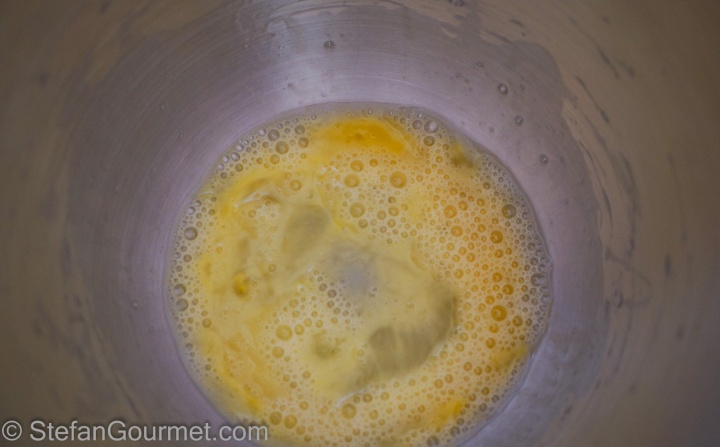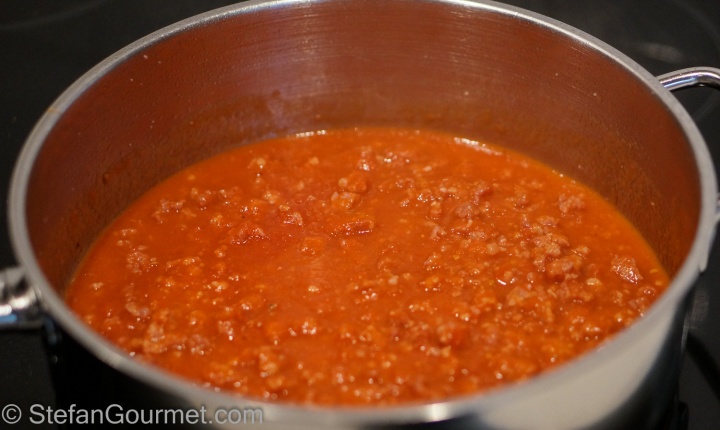
Bologna is famous for being the food capital of Italy. The best-known pasta dishes from Bologna are tagliatelle (not spaghetti!) alla bolognese and lasagne alla bolognese, both made with fresh egg pasta and the famous ragù alla bolognese. Being the food capital of Italy, those are by far not the only typical pasta dishes from the city. Another example that I covered on this blog is tortellini in brodo. But also gramigna al ragù di salsiccia is a classic from Bologna. In its basic form the ragù only has three ingredients: sausage, tomatoes, and wine. Gramigna are short hollow tubes of pasta, made with an extruder. It is absolutely delicious in its simplicity.
There are three basic ways of giving pasta its shape: extrusion, rolling out, and hand-shaped. By far the most pasta that is consumed world-wide is extruded, as that is how most store-bought pasta is produced. Spaghetti is the best known example of this. Homemade pasta is most often rolled out or hand-shaped. Sheets of rolled-out fresh pasta dough are subsequently used to make ravioli, lasagne, tagliatelle, etc. The dough is rolled out using a rolling pin or a pasta machine. Examples of hand-shaped pasta include orecchiette, malloreddus, and cicatielli. For these no special equipment is needed, except in some cases something to make ridges.

The main reason why pasta is not being extruded at home as much, is that pasta extruders are not common in households anymore and that they are not as easy to work with. I acquired mine, a very simple hand-cranked model, in Italy and use it only once in a while. If you have a stand mixer, you can probably get a pasta extrusion attachment for it. You will need a different drawplate for each pasta shape. For gramigna you will need one that makes thin hollow tubes, either smooth (lisce) or with ridges (rigate). For easiest operation the dough needs to be as dry as possible while still being supple enough to work it through the extruder. If the dough is too sticky, it will stick together like crazy when it comes out the extruder.
If you don’t have a pasta extruder you can still prepare this tasty sausage ragù and serve it with another type of pasta.
Ingredients
75 grams (1/2 cup) semola di grano duro rimacinata (semolina flour)
75 grams (1/2 cup) Italian 00 flour
1 egg
1 tsp olive oil
water as needed
200 grams (1/2 can) of peeled tomatoes, pureed in the food processor
80 ml (1/3 cup) dry white wine
2 sweet Italian pork sausages, about 170 grams (6 oz)
freshly grated parmigiano reggiano
salt
Preparation

I used my stand mixer to make the dough. Of course you can also make it by hand or use a food processor to mix the dough and then knead it by hand.
Start by beating the egg.

Mix with the paddle attachment until you get crumbs.

Now add just enough water to allow the dough to come together.

Start by adding water by the tablespoon and wait until it has been incorporated fully into the dough. End by adding it by the teaspoon only. If you add too much water and the dough becomes sticky, add a bit more flour.

Once the dough has come together, switch over to the dough hook and knead on medium speed for 10 minutes or until the dough is very smooth and pliable. Add a bit more flour if it becomes sticky. The dough should be as dry as you can get it while it is still smooth and pliable.

Wrap the dough in cling film and allow to rest for half an hour outside of the refrigerator.

In the meantime, prepare the ragù. Start by taking the sausage out of its casing, and mince the sausage meat.

Put the sausage meat in a frying pan over medium high heat. No oil is needed as the sausage is fatty enough of its own.

Cook over medium high heat until the sausage has lost its raw color and starts to sizzle.

Allow most of the wine to evaporate.

Bring to a boil and then reduce to a simmer.

Simmer, uncovered, stirring now and then, until the sauce has a nice thick consistency. Once it is finished, taste and adjust the seasoning with salt if needed. Keep the sauce warm over very low heat. Add a bit of water if it becomes too dry.

When the dough has rested, work it through the extruder.

The gramigna should be about 5 cm (2 inches) long. I found I got best results by extruding 5 cm of dough, cutting off the individual gramigna, extruding another 5 cm, etc.

An alternative is to extrude much longer tubes of dough and then cut them into gramigna, but I found this made them thinner (because the tubes stretch by their own weight) and didn’t give them the characteristic bent shape.

Arrange the gramigna in a single layer on a lightly floured surface.
Make sure a large pot of water boils by the time you are finished making all of the gramigna.

Add salt and the gramigna to the boiling water.

The gramigna take about 3 minutes to become al dente. Taste one to make sure they are cooked to your liking.

Then use a strainer to transfer the gramigna to the sauce.

Toss to mix. Add a bit of the cooking water if needed.

Serve on preheated plates, sprinkled with a bit of freshly grated parmigiano.
Wine pairing
The traditional wine pairing for this is obviously a sangiovese di romagna. This red from the region of Bologna is made from the same type of grapes as Chianti (i.e. sangiovese), but because of the richer soil the wine is a bit rounder. A regular Chianti would also work, if it is not too tannic. The acidity of sangiovese-based wines works well with both the tomatoes and the sausage. A delicious alternative is a cirò from Calabria, which also has considerable acidity.
Flashback

My flashbacks are starting to get a bit out of season, as over this summer I have posted less recipes (and more restaurant reviews) than two years ago. These skewers of tender juicy chicken thigh meat are basted with a yakitori/teriyaki marinade. This way of cooking chicken yakitori on the grill is very easy and delicious.






Great & thanks Stefan for this pasta recipe. I was thinking of trying to make pasta with kitcen aid but wasn’t sure how to proceed since I have only ever made pasta by hand up till now – all solve now I will follow your tips!
LikeLike
Great! Do you have the pasta press attachment?
LikeLiked by 1 person
Yes 🙂 I hope they will come out as beautiful as yours!
LikeLike
Can’t wait to see you post about this 🙂
LikeLiked by 1 person
Love it! If I got one of those machines, I would use it twice a year. Perhaps not worth the investment.
LikeLike
I guess I’ve been using it about twice a year since acquiring it 7 years ago. Luckily the ‘investment’ as I remember was something like 30 euros.
LikeLiked by 1 person
I know what Conor means but I always justify my kitchen gadget investments on the basis that food is my hobby and one that gives pleasure to others as well. I’m sure a pasta extruder has much entertainment value – I still remember a visit to a pasta factory years ago and being fascinated by how the bend in the macaroni is formed : )
LikeLiked by 1 person
I’ve been using a recipe from Marc Vetri for extruded pasta for a few years now. It’s given me the best texture Stefan with nothing more than semolina and water. I use a machine that looks very similar to yours. The other key to his recipe is making sure to dry the extruded pasta for several hours or even more.
http://ovendriedtomatoes.com/2012/01/25/fresh-extruded-pasta-rigatoni-sausage-and-ricotta/
LikeLike
I always thought the drying is only to prevent sticking together, or does it do something else?
LikeLike
I only dry extruded pasta for extended periods. Specifically following the recipe that has only semolina and water. This is done in the fridge uncovered for at least 8 hours. It really has a big impact on the texture. The longer it is dried the closer to “artisan” dry pasta it is. It has a toothsome sturdy texture very different than when we make pasta with eggs and white flour. I can send you the recipe if you would like to give it a shot Stefan.
LikeLike
I’ll definitely try it if you send me the recipe.
If you dry it to 12.5% water content, it will *be* artisan dry pasta.
LikeLike
Oh no. I’m sure it’s never dried to that extent. Only one way to find out… weigh it before and after 🙂 I’ll forward you the recipe.
LikeLike
Thanks. Fresh pasta before drying is about 33% water, so it will take quite a bit of drying to get to 12.5%.
LikeLike
Great post, Stefan, with a delicious sauce at its heart. Pork gives such a great flavor to tomato sauce and well-seasoned sausage even more so. We purchased some fresh pork from a farmer friend and Zia and I have been taking full advantage of the bounty. It’s been a long time when we’ve had pork as good as this.
Love your hand-cranked extruder. Unless and until I do some major rearranging in my kitchen and adjoining room, there will be no new appliances, no matter the size, brought into this home!!! (I’ll let you know how that goes.) 🙂
LikeLiked by 1 person
I admit to cheating with the pasta – but every other word of the recipe was dutifully adhered too! (Though I read a half cup of wine and added it before checking the mls – a cup here is 250 ml. I can positively state that the recipe did not suffer from this error.)
Simple and delicious.
LikeLike
Thanks! Even though the amount of wine isn’t very critical for this recipe, I should correct it. I did mean 80 ml or 1/3 cup.
LikeLike
What a great dish. Thanks a lot for sharing.
LikeLike
Hi Linda, thanks for visiting and taking the time to comment.
LikeLike